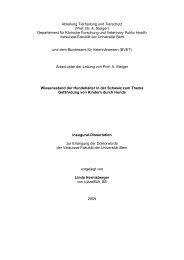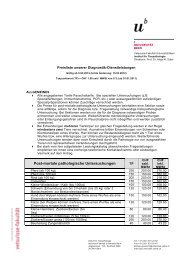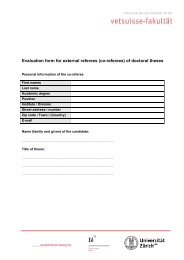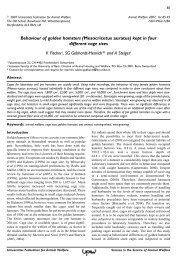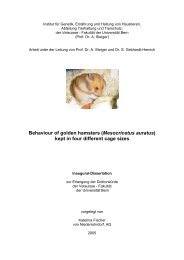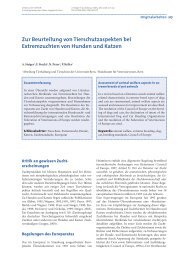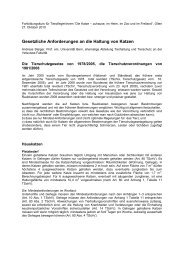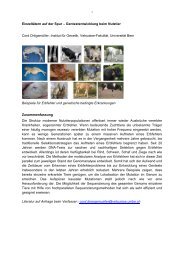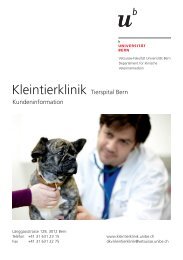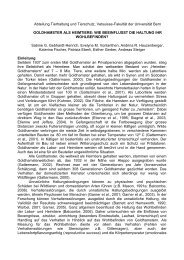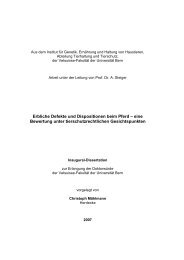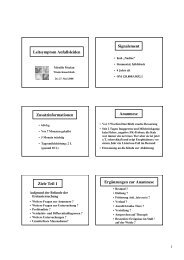Radiographic findings in several joints of nine bears
Radiographic findings in several joints of nine bears
Radiographic findings in several joints of nine bears
You also want an ePaper? Increase the reach of your titles
YUMPU automatically turns print PDFs into web optimized ePapers that Google loves.
Mots-clé: euthanasie, gériatrie, mammifères de zoo, pathologie, scor<strong>in</strong>g system, symptôme<br />
Résumé<br />
La décision d’effectuer une euthanasie d’un animal gériatrique est une procédure très<br />
complexe <strong>in</strong>cluant des facteurs éthiques, médicaux, émotionnels et parfois politiques.<br />
Cependant, la nécropsie ultérieure de ces animaux met souvent en évidence des changements<br />
pathologiques déjà bien avancés des organes et / ou du système locomoteur. C’est pourquoi<br />
nous faisons l’hypothèse que l’euthanasie est souvent retardée au détriment du bien-être de<br />
l’animal. Le but de cette étude est de faciliter et d’établir un cadre pour une décision <strong>in</strong>itiale<br />
objective lors d’euthanasie chez les animaux gériatriques. Un « scor<strong>in</strong>g system » sur la<br />
condition physique et la qualité de vie des vieux animaux de zoo y est présenté, basé sur une<br />
<strong>in</strong>vestigation rétrospective et prospective sur 70 mammifères gériatriques de zoo dans c<strong>in</strong>q<br />
zoos européens. Les dossiers médicaux et les rapports de nécropsie ont été étudiés pour les<br />
cas rétrospectifs. Des symptômes ont été observés et archivés pour les cas prospectifs. Des<br />
<strong>in</strong>vestigations radiographiques sous anesthésie générale ou avant nécropsie ont été effectuées<br />
en plus. Une association significative entre les symptômes et les pathologies a révélé que<br />
63.1% des animaux exam<strong>in</strong>és (n = 41/65) présentaient des pathologies du système locomoteur<br />
(36.9%) ou souffraient de néoplasie (26.2%). Sur la base de rapports <strong>in</strong>dividuels, 28<br />
vétér<strong>in</strong>aires de différents doma<strong>in</strong>es en médec<strong>in</strong>e vétér<strong>in</strong>aire ont par ailleurs conclu que ces<br />
animaux présentaient des douleurs et un <strong>in</strong>confort allant de léger à sévère a<strong>in</strong>si qu’une qualité<br />
de vie significativement réduite, entraînant un bien-être fortement restre<strong>in</strong>t de l’animal. Le<br />
« scor<strong>in</strong>g system » proposé <strong>in</strong>clut tous ces facteurs et <strong>of</strong>fre un outil simple et efficace pour<br />
soutenir la décision d’effectuer une euthanasie chez les mammifères gériatriques de zoo.<br />
Introduction<br />
In the last years <strong>of</strong> the 20 th century zoos became <strong>in</strong>creas<strong>in</strong>gly focused on conservation<br />
(through captive breed<strong>in</strong>g), research and education. This has been <strong>in</strong> part due to chang<strong>in</strong>g<br />
public attitudes towards zoos and the appropriate methods <strong>of</strong> keep<strong>in</strong>g wild animals <strong>in</strong><br />
captivity (Young 2003). In addition, the conditions <strong>of</strong> captivity <strong>of</strong> zoo animals have<br />
improved and the animal longevity has been <strong>in</strong>creased. As a result, problems aris<strong>in</strong>g from<br />
the management <strong>of</strong> long-lived species and age-related diseases are <strong>in</strong>creas<strong>in</strong>g. Some <strong>of</strong> the<br />
problems may be difficult to diagnose and treat, thereby potentially compromis<strong>in</strong>g animal<br />
welfare (Kitchener 2004). In many cases, the subjects are apparently healthy, but old zoo<br />
animals at necropsy are found to suffer from a range <strong>of</strong> health problems that may not have<br />
been apparent when they were alive (Richardson 2000). Animals <strong>in</strong> captivity <strong>in</strong>variably live<br />
longer than their wild counterparts (Nowak 1999; Richardson 2000; Erw<strong>in</strong> et al 2002).<br />
Enabl<strong>in</strong>g zoo animals to live <strong>in</strong> better conditions for a long period is presently viewed as<br />
important. However, zoos <strong>of</strong>ten unwitt<strong>in</strong>gly condemn their animals to long pa<strong>in</strong>ful lives. In<br />
some <strong>in</strong>stance this may benefit the conservation <strong>of</strong> genetic l<strong>in</strong>eages. However, <strong>in</strong> other<br />
<strong>in</strong>stances the already well-represented animal occupies much needed space well beyond<br />
mak<strong>in</strong>g a significant contribution to the breed<strong>in</strong>g program. A good zoo strives to improve<br />
the quality <strong>of</strong> its animals’ lives, not necessarily their length <strong>of</strong> life (Richardson 2001).<br />
Suffer<strong>in</strong>g is an unpleasant state <strong>of</strong> m<strong>in</strong>d that disrupts the quality <strong>of</strong> life. It is the mental<br />
state associated with unpleasant experiences such as pa<strong>in</strong>, malaise, distress, <strong>in</strong>jury and<br />
emotional numbness (Gregory 2004). In the present study we focused on pa<strong>in</strong>, because pa<strong>in</strong>,<br />
probably more than any other state, directly reduces welfare (Duncan 2004).<br />
Generally, it is very difficult to determ<strong>in</strong>e the appropriate time when to perform<br />
euthanasia. Besides the medical aspect, the zoo veter<strong>in</strong>arian must take <strong>in</strong>to consideration the<br />
different <strong>in</strong>terests <strong>of</strong> zoo managers and staff, visitors, animal welfare organizations, sponsors<br />
and possibly the needs <strong>of</strong> the respective breed<strong>in</strong>g programs (e.g. European Endangered<br />
12



